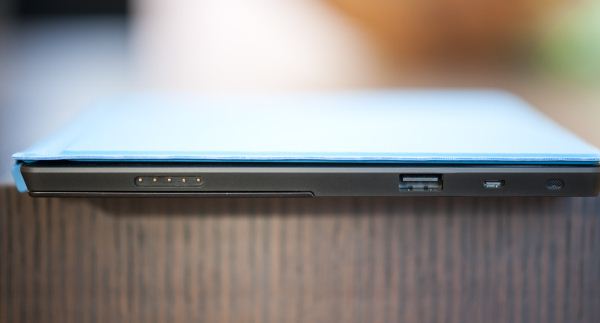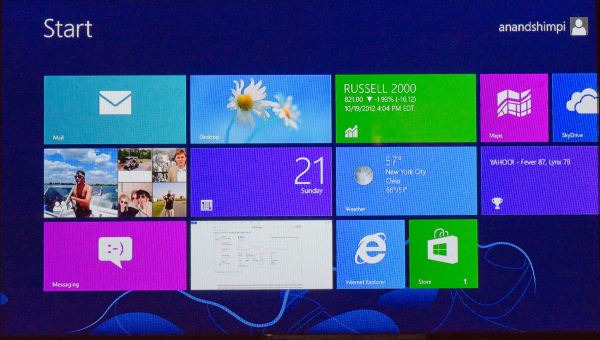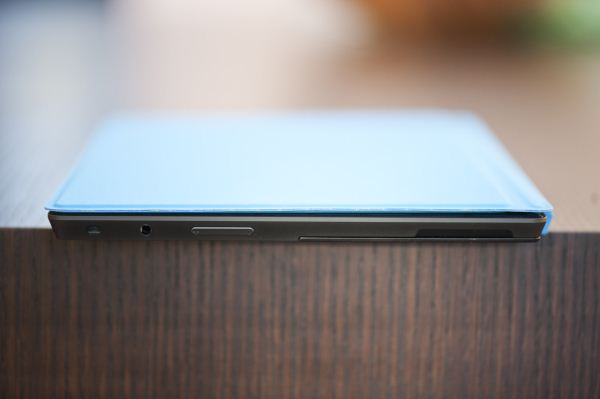Microsoft Surface Review
by Anand Lal Shimpi on October 23, 2012 9:01 PM EST- Posted in
- Tablets
- Microsoft
- Mobile
- Surface
- Windows RT
A Plethora of Ports and Storage Options
One area where Surface is a significant departure from the iPad is in its IO and expansion. The iPad features a single dock (and soon to be Lightning) connector, while Surface looks more like a laptop (or Android tablet) when it comes to IO.
There’s no port for syncing, you get content onto Surface via WiFi or a more traditional method. Surface has a single USB 2.0 port on the right side of the device. You can plug almost anything you want into this port, including USB storage devices of course. Behind the kickstand is a single microSD card slot, giving you another option for expansion.
On the left edge of the device there’s a micro-HDMI out port that can be paired with a Microsoft made VGA or HDMI dongle (both dongles have a 22-degree connector on them to mate flush with Surface). I tested HDMI output with Microsoft's dongle and unfortunately the result wasn't very good. The 1080p output had a lot of issues with scaling quality (as you can see from the shot below) and there was a lot of tearing on the screen with a big impact on UI frame rate. I reached out to Microsoft for an explanation but have yet to hear anything.
Finally there’s a standard 1/8” headphone jack along the top of the device.
Power delivery comes via a custom magnetic connector along the lower right side of Surface.
Given that the internal storage is an eMMC solution, performance from the microSD slot with a good card should be fairly comparable. In practice I could read and write a large sequential file at roughly 10.5 MB/s using a SanDisk microSD card.
Copying from a fast USB stick to Surface’s internal storage gave me transfer rates closer to 17MB/s. There are a few vendors for Windows 8/RT eMMC devices, I’ll be paying close attention over the coming weeks to figure out who makes the best. I know Microsoft and Intel (among others) have been playing close attention to the eMMC providers with hopes of weeding out those that deliver honestly unacceptable performance.
While doing background file IO I didn’t notice any of the stalling/pausing that we’ve seen on some of the more recent Android tablets.
Update: Many have asked about how much storage is taken up by the Windows + Office 2013 installs. The screenshot below shows the directory size for both C:\Windows and C:\Program Files, the latter is where the Office15 install files are included (and yes winword.exe is still the Word executable).
You're looking at roughly 6.47GB for Windows RT and then another 830MB for Office for a grand total of around 7.3GB.
USB Compatibility
Microsoft is particularly proud of its single USB 2.0 port on Surface. Although USB ports have been featured on several Android tablets, their support was typically limited to flash drives, keyboards and mice. With Windows RT, Microsoft wants to bring more of the traditional Windows experience to tablets. Had Surface been x86 based, you would be able to plug in virtually any USB peripheral and it would just work. As the first version of Surface is based on an ARM SoC, driver support is a little more limited but still pretty decent.
USB drives obviously work as you’d expect them to. Even SATA to USB adapters worked fine when plugged into Surface. Other smartphones and tablets also worked, although their level of support varied. For example, you can plug in the iPhone 5 and have it come up as a supported device for moving pictures to/from. However USB tethering is not supported by the class driver included in Windows RT. You can even plug an iPad into Surface and get the same level of support.
Printer support is pretty decent, although the Epson Workforce 910 I tried didn’t actually have specific driver support under RT. Although development for the desktop side of Windows is limited, manufacturers can supply Windows RT drivers to enable support for some more obscure devices. Unfortunately when it comes to those devices you’ll have to play the waiting game as there’s simply not a lot of third party Windows RT drivers available for download today.






_575px.png)








235 Comments
View All Comments
WP7Mango - Thursday, October 25, 2012 - link
No. That's what the Surface Pro is for.tzhu07 - Thursday, October 25, 2012 - link
If I were to buy a tablet today, I'll still take the iPad for the most widespread support.kyuu - Thursday, October 25, 2012 - link
So what's up with the Windows RT review? Really looking forward to it, but it's a day+ late now (at least I thought I saw that it was supposed to be up later the same day of the Surface review). =(kyuu - Thursday, October 25, 2012 - link
So what's up with the Windows RT review? Really looking forward to it, but it's a day+ late now (at least I thought I saw that it was supposed to be up later the same day of the Surface review). =(simbadogg - Thursday, October 25, 2012 - link
I believe on microsofts spec/surface page they said it was a proprietary connection for HDMI / video out. Is this a standard micro HDMI connector? If so what type (C, D?). Just wanting to know if there can actually be other cables used other than the standard microsoft cable.HisDivineOrder - Thursday, October 25, 2012 - link
Windows RT reminds me so much of XP x64. I think that the next full release/update of RT will be a lot better than this one. I think by then it'll become clear that apps launching slowly and overall lethargic performance is part of what Jobs KNEW was an important component of having a slick, awesome device.Your device has to "feel" fast in order for users to think it's fast. It may not be actually fast, but they have to feel like it is. Every review says the same thing. "It's great, it's different, I really like it, I want to love it, but it's so slow..."
It feels slow because the transitions are slow and the design was not built around tricking the user into thinking it's faster than it is. The whole iOS core started around doing this very thing. Tricking the user into thinking slow hardware was fast with clever use of transitions and design.
It seems like MS did not learn this lesson. Hell, it was in the Jobs biography. Perhaps they should read more.
antef - Thursday, October 25, 2012 - link
Anand, you mention having to double-press or long-press to switch apps on other platforms, but that's not the case with Android in general, only with the new Samsung and LG phones. The other manufacturers rightly went with the Google standard of including a dedicated button for app switching, so it's one press to bring up a list with thumbnails and another press to go to the app you want. I don't think MS's implementation is any better than that. This is the issue with most people using Samsung's and LG's poor designs and not realizing Android is better elsewhere. Of course, Windows RT still wins when it comes to side-by-side mode.tipoo - Thursday, October 25, 2012 - link
A few reviews complained about using the stand on a lap or any non-level surface being unsteady, with the touch cover you can flip it back half way and then have the stand resting on THAT rather than your lap. That should be much more stable as it now has a level surface and much more surface area.pblock - Thursday, October 25, 2012 - link
Thank you for a wonderful, comprehensive review. However, at our office, most of the talk is wondering if the Surface will be usable on your lap. Does the stand work on your lap, or is it too awkward? And what about each of the keyboard covers? Most of us who use laptops rarely place them on a table or desk but instead are using them on the couch or in an easy chair.techenthu - Thursday, October 25, 2012 - link
It has a USB port . Can i use a data card with this?I am sure carriers need some installation before use the data card . So i was wondering if surface will allow using the data card